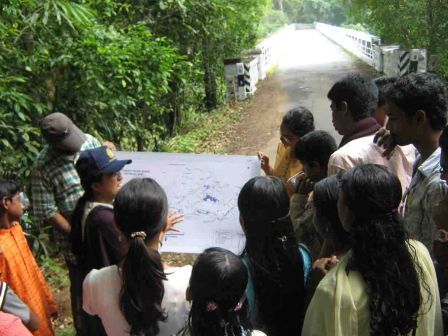Rivers
Narmada: Land at last - Video Volunteers
Posted on 22 Mar, 2011 11:55 AMArticle and Video Courtesy: Video Volunteers
Patterns of diversity and conservation status of freshwater fishes in the tributaries of river Ramganga in the Shiwaliks of the Western Himalaya – A paper in Current Science
Posted on 20 Mar, 2011 09:47 PMOne tributary was within a protected area (PA; Corbett National Park); the other two were outside the PA (Lansdowne Forest Division). Cast nets were used for fish sampling, which was done from 9.00 a.m. to 5.00 p.m.
Review of Krishna Water Disputes Tribunal - A report on Krishna river water allocations
Posted on 08 Mar, 2011 04:42 PMThis is a review of KWDT-2 report analysing how it has failed to protect the long term sustainable productivity and ecology of the river basin. It has also failed to understand the water allocations done by previous KWDT-1. KWDT-2 also negated the earlier KWDT-1 allocations at the same time categorically stating that it cannot change water use allocations of previous award.
River schools can make the future look bright - Parineeta Dandekar
Posted on 04 Mar, 2011 01:25 PM Above - Children studying a map of the Chalakudy Basin. Photo - RRC.
Above - Children studying a map of the Chalakudy Basin. Photo - RRC.
Seeds of sustainability and sensitivity when sown at a young age, blossom into responsible individuals. And you need to be in touch with the land to sow those seeds. The Central and State Boards of Education in India have made Environmental Science a compulsory subject for schools and junior colleges (for all subjects). But Environmental Sciences is not to be studied in the classroom. In order to understand the erosion and deposition processes of a river, students need to visit a river bend in their city and in order to instil a lifelong aversion to plastic bags, a landfill and dumping grounds need to be seen.
25 years of the Narmada struggle - Ordinary people, extraordinary movement
Posted on 03 Mar, 2011 11:15 AMArticle and Images by: National Alliance of People's Movements
Review needed on Krishna Water Tribunal analysis on Alamatti Dam to save the farmers from dangerous consequences
Posted on 15 Feb, 2011 11:57 AMProf.T.Shivaji Rao, Director, Center for Environmental Studies, Gitam University and former member of the Environmental Appraisal Committee of Union Government in 1990 when the Alamatti project was placed before the committee for clearance.
Two ancient irrigation systems of India - Paper presented at the National Seminar on Water and Culture (2007)
Posted on 14 Feb, 2011 05:03 AMThe Phad system of irrigation, is found in Maharashtra over the rivers Panzara, Girna and Burai, which are tributaries of Tapi.
Water management in the Vijaynagar empire - Paper presented at the National Seminar on Water and Culture (2007)
Posted on 14 Feb, 2011 01:55 AMThis paper focuses on water management techniques used in two tanks constructed by the kings of the Vijaynagar Empire.
The first example taken, is that of the Anantraj Sagar built by the son of the minister of Harihar. The lake is still in use and there are inscriptions on stone near it which provide a thumb rule to constructing lakes. Construction of this lake began in 1369 and was completed in 2 years. The paper states that the length of the dam was 5000 dand, width was 8 dand and the height was 7 dand (One dand is about one metre).
Ideal historical river water use systems - Paper presented at the National Seminar on Water and Culture (2007)
Posted on 14 Feb, 2011 12:02 AMThe Phad system of irrigation which has been going on for centuries, is found in the northwestern parts of Maharashtra in the three river basins of Panjhra, Mosam, Kan and Aram. Weirs were constructed on these rivers to divert water for agriculture use. These weirs are locally called Bandhara. Each independent Phad system comprises of a diversion weir, a canal on the bank and distributor channels for irrigation.